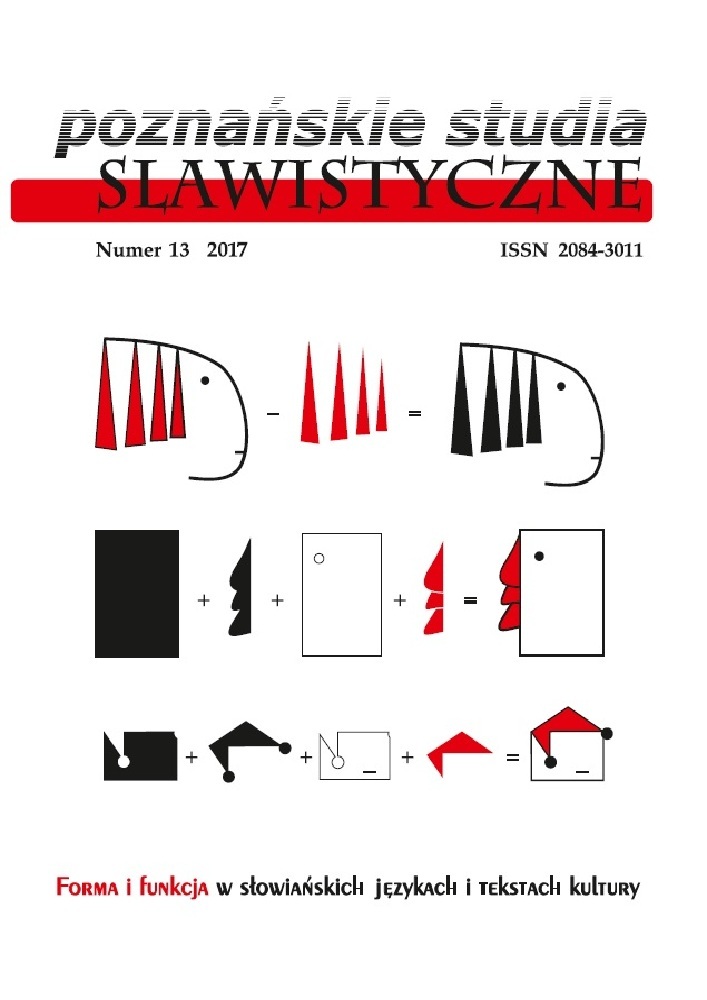Abstrakt
In this paper we consider opening greetings and complementary closes (farewells) in emails written in Serbian language that make relatively independent communication entities with the most general purpose of initiating and concluding a correspondence as the form of phatic language function and in the same time with metalinguistic discourse function of indicating the beginning and the end. We examine their structure and lexical, semantic and pragmatic properties, and also stress the occurrence of new characteristics or tendencies in their use caused by this new medium of communication, i.e. email, as compared to traditional letter correspondence. Those are: higher degree of linguistic individualization, expression of creativity in communication, resorting to economy, linguistic reductions and omissions.Bibliografia
Apresân, Û.D., 1980, Tipy informacii dlâ poverhnostno-semantičeskogo komponenta modeli „Smysl – Tekst”, Wiener Slawistischer Almanach, Sonderband 1. Wien: Institut für Slawistik der Universität.
https://doi.org/10.3726/b12934
Baron, N.S. (2000). Alphabet to Email: How Written English Evolved and Where It's Heading. New York and London: Routledge.
Baron, N.S. (1998). Writing in the Age of Email: The Impact of Ideology versus Technology. „Visible Language”, no. 32 (1), str. 35–53.
Bergel’son, M.B. (2002). Âzykovye aspekty virtual’noj kommunikacii. „Vestnik MGU” ser. 19, no. 1. russcomm.ru/rca_biblio/b/bergelson-text07.doc. 2.02.2016.
Brown, R., Gilman, A. (1960), The Pronouns of Power and Solidarity. U: Style in Language. Ed. T.A. Sebeok. Cambridge–Massachusetts: MIT Press, str. 253–276.
Collot, M., Belmore, N. (1996). Electronic Language: A New Varity of English. U: Computer-Mediated Communication: Linguistic, Social and Cross-Cultural Perspective. Ed. S. Herring. Amsterdam: John Benjamins Publishing Company, str. 13–28.
Crystal, D. (2001). Language and the Internet. Cambridge: University Press.
https://doi.org/10.1017/CBO9781139164771
Danet, B. (2002). The language of email. http://www.europhd.it/html/_onda02/04/ss8/pdf_files/lectures/Danet_email.pdf. 2.02.2016.
Félix-Brasdefer, C. (2012). Email Openings and Closings: Pragmalinguistic and Gender Variation in Learner-Instructor Cyber Consultations. „Utrecht Studies in Language and Communication”, vol. 24, str. 223–248.
Graovac, D. (2010). Diskurs internetskog foruma (na primeru Foruma B 92). Novi Sad [neobjavlen magistarski rad].
Hallajian, А., Khemlani David, М. (2014). “Hello and Good Day to you Dear Dr. …” Greetings and Closings in Supervisors-supervisees Email Exchanges. “Procedia – Social and Behavioral Sciences”, vol. 118, str. 85–93.
Jakobson, R. (1966). Lingvistika i poetika. Beograd: Nolit.
Jocić, M. (2011). Oslovlavaњe i obraćaњe. U: Govor Novog Sada, sv. 2. Ur. V. Vasić, G. Štrbac. Novi Sad: Filozofski fakultet, Odsjek za srpski jezik i lingvistiku, str. 297–346.
Lazić-Koњik, I. (2015). Elektronski diskurs. Završni pozdrav u mejlovima. „Jezik danas”, no. 3–4. Novi Sad: Matica srpska, str. 4–15.
Mallon, R., Oppenheim, C. (2002). Styles used in electronic mail. „Aslib Proceedings”, no. 54 (1)”, str. 8–22.
Pešikan, M., Jerković, J., Pižurica, M. (ur.). (2010). Pravopis srpskoga jezika. Novi Sad: Matica srpska.
Piper, P. (2006). O vvodnyh dialogah v slavânskih âzykah. „Južnoslovenski filolog”, no. LXII. Beograd: Srpska akademija nauka i umetnosti i Institut za srpski jezik SANU, str. 15–32.
Popovič, L. (2000). Èlektronnaâ počta – novyj èpistolârnyj podžanr. U: Sbornik dokladov V Meždunarodnogo simpoziuma „Sostoânie i perspektivy sopostavitel’nogo issledovaniâ russkogo i drugih slavânskih âzykov”. Belgrad: Filološki fakultet, str. 211–218.
Popović, L. (2000). Epistolarni diskurs ukrajinskog i srpskog jezika. Beograd: Filološki fakultet.
Popović, Lj. (2009). Leksičke inovacije u elektronskom diskursu srpskog i hrvatskog jezika. U: Die Unterschiede zwischen dem Bosnischen/Bosniakischen, Kroatischen und Serbischen. Lexik – Wortbildung – Phraseologie. Ur. B. Tošović, str. 165–183. http://www.ukrajinistika.edu.rs/index.php/2012-03-10-22-27-04/311-2014-05-10-13-02-25 /. 2.02.2016.
Radić-Bojanić, B. (2007). neko za chat!?: diskurs elektronskih ćaskaonica ne engleskom i srpskom jeziku. Novi Sad: Filozofski fakultet i Futura publikacije.
RSANU: Rečnik srpskohrvatskog kњiževnog i narodnog jezika. Knj. 4 (1966). SANU. Beograd: Srpska akademija nauka i umetnosti.
Savić, S., Stanojević, D. (2012). Oslovlavaњe i pozdravlaњe u srpskom jeziku: pregled istraživaњa (1979–2011). U: Iz riznice multijezičke Vojvodine: oslovlavaњe i podravlaњe u savremenim jezicima nacionalnih zajednica u Vojvodini. Ur. D. Stanojević, S. Savić. Novi Sad: Pedagoški zavod Vojvodine, str. 99–152. http://www.pzv.org.rs/files/zbornik8_2012.pdf. 2.02.2016.
Tošovič, B. (2012a). Internet-stilistika. U: Logičeskij analiz âzyka. Adresaciâ diskursa. Ur. N.D. Arutûnova. Moskva: Indrik, str. 482–495. http://www-gewi.uni-graz.at/gralis-alt/GraLiS_TB/Bibliographie/pdf/Tosovic_Internet-stilistika_2012.pdf. 2.02.2016.
Tošovič, B. (2012b). Internet-stili. U: Stilistika segodnâ i zavtra. Plenarnye doklady Materiâly konferencji. Moskva: MediaMir, str. 181–186.
Waldvogel, Ј. (2007). Greetings and Closings in Workplace Email. „Journal of Computer-Mediated Communication”, br. 12, str. 456–477.
https://doi.org/10.1111/j.1083-6101.2007.00333.x
Wierzbicka, A. (1971). Metatekst w tekście. U: O spójności tekstu. Ur. M.R. Mayenowa. Wrocław, str. 105–121.
Yates, S.T. (1996). Oral and Written Linguistics Aspects of Computer Conferencing: A Corpus Based Study. Y: Computer-Mediated Communication: Linguistic, Social and Cross-Cultural Perspective. Ur. S. Herring. Amsterdam: John Benjamins Publishing Company, str. 29–46.
Licencja

Utwór dostępny jest na licencji Creative Commons Uznanie autorstwa – Bez utworów zależnych 4.0 Międzynarodowe.
